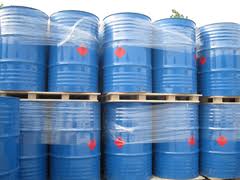Difference between revisions of "Isobutylacetate"
(→Description) |
|||
| Line 8: | Line 8: | ||
}} | }} | ||
==Description== | ==Description== | ||
| − | The chemical compound isobutyl acetate, also known as 2-methylpropyl ethanoate (IUPAC name) or β-methylpropyl acetate, is a common solvent. It is produced from the esterification of isobutanol with [[Acetic Acid]]. Like many esters it has a fruity or floral smell at low concentrations and occurs naturally in raspberries, [[pears]] and other [[plants]]. At higher concentrations the odour can be unpleasant and may cause symptoms of central nervous system depression such as nausea, dizziness and headache.<br><br> | + | The chemical compound isobutyl acetate, also known as 2-methylpropyl ethanoate (IUPAC name) or β-methylpropyl acetate, is a common solvent. It is produced from the esterification of [[isobutanol]] with [[Acetic Acid]]. Like many esters it has a fruity or floral smell at low concentrations and occurs naturally in raspberries, [[pears]] and other [[plants]]. At higher concentrations the odour can be unpleasant and may cause symptoms of central nervous system depression such as nausea, dizziness and headache.<br><br> |
==Application== | ==Application== | ||
| Line 20: | Line 20: | ||
Auto ignition temperature: 422°C<br><br> | Auto ignition temperature: 422°C<br><br> | ||
For overseas carriage aspects of [[Chemicals]], the readers are recommended to acquire or have access to a good chemical dictionary, and a copy of the International Maritime Dangerous Goods (IMDG) Code, issued by the International Maritime Organisation. Also consult the applicable MSDS sheet.<br><br> | For overseas carriage aspects of [[Chemicals]], the readers are recommended to acquire or have access to a good chemical dictionary, and a copy of the International Maritime Dangerous Goods (IMDG) Code, issued by the International Maritime Organisation. Also consult the applicable MSDS sheet.<br><br> | ||
| + | |||
| + | See also: http://www.chemicalland21.com/industrialchem/solalc/ISOBUTYL%20ACETATE.htm<br><br> | ||
[[Category: Products]][[Category: Oil and chemicals]] | [[Category: Products]][[Category: Oil and chemicals]] | ||
Latest revision as of 12:48, 28 October 2013
| Infobox on Isobutylacetate | |
|---|---|
| Example of Isobutylacetate |  |
| Facts | |
| Origin | - |
| Stowage factor (in m3/t) | - |
| Humidity / moisture | - |
| Ventilation | - |
| Risk factors | See text |
Isobutylacetate
Description
The chemical compound isobutyl acetate, also known as 2-methylpropyl ethanoate (IUPAC name) or β-methylpropyl acetate, is a common solvent. It is produced from the esterification of isobutanol with Acetic Acid. Like many esters it has a fruity or floral smell at low concentrations and occurs naturally in raspberries, pears and other plants. At higher concentrations the odour can be unpleasant and may cause symptoms of central nervous system depression such as nausea, dizziness and headache.
Application
Use; solvent for nitrocellulose; in thinners, sealants, and topcoat lacquers; perfumery; flavouring agent.
Shipment / Storage / Risk factors
Flammable, dangerous fire risk. TLV: 150 ppm in air.
The product is soluble in alcohols, ether and hydrocarbons; partially soluble in water.
Freezing point: -99°C
Flash point: 17,7°C
Boiling point: 116°C
Auto ignition temperature: 422°C
For overseas carriage aspects of Chemicals, the readers are recommended to acquire or have access to a good chemical dictionary, and a copy of the International Maritime Dangerous Goods (IMDG) Code, issued by the International Maritime Organisation. Also consult the applicable MSDS sheet.
See also: http://www.chemicalland21.com/industrialchem/solalc/ISOBUTYL%20ACETATE.htm











